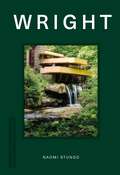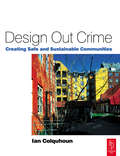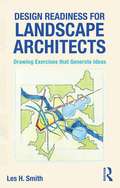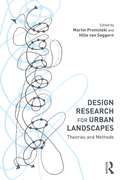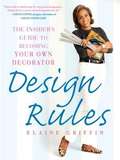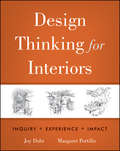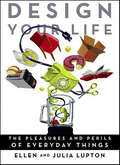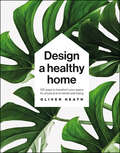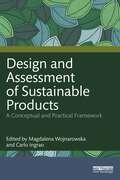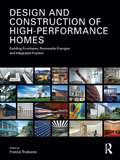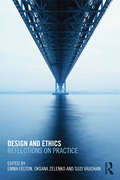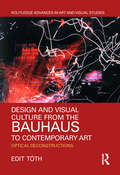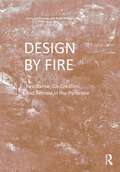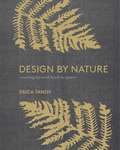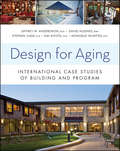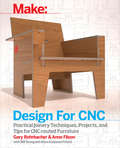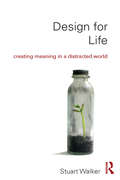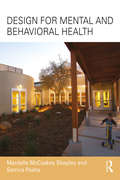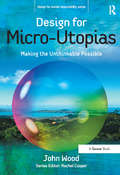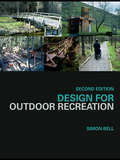- Table View
- List View
Design Mom: How to Live with Kids: A Room-by-Room Guide
by Gabrielle Stanley BlairNew York Times best seller Ever since Gabrielle Stanley Blair became a parent, she’s believed that a thoughtfully designed home is one of the greatest gifts we can give our families, and that the objects and decor we choose to surround ourselves with tell our family’s story. In this, her first book, Blair offers a room-by-room guide to keeping things sane, organized, creative, and stylish. She provides advice on getting the most out of even the smallest spaces; simple fixes that make it easy for little ones to help out around the house; ingenious storage solutions for the never-ending stream of kid stuff; rainy-day DIY projects; and much, much more.
Design Monograph: Perriand
by Dominic LutyensA design monograph series on the most remarkable architects, designers, brands and design movements of the twentieth and twenty-first centuries, each book contains a historical-critical essay discussing the life and work of the subject, followed by an illustrated appreciation of groundbreaking work.French architect and designer Charlotte Perriand not only created buildings such as the League of Nations in Geneva and ski resorts but was responsible for iconic furniture pieces in tubular steel, such as the Nuage bookshelf, Grand Confort chair (while working for Le Corbusier), B301 recliner and the ponyskin Chaise Longue.
Design Monograph: Perriand
by Dominic LutyensA design monograph series on the most remarkable architects, designers, brands and design movements of the twentieth and twenty-first centuries, each book contains a historical-critical essay discussing the life and work of the subject, followed by an illustrated appreciation of groundbreaking work.French architect and designer Charlotte Perriand not only created buildings such as the League of Nations in Geneva and ski resorts but was responsible for iconic furniture pieces in tubular steel, such as the Nuage bookshelf, Grand Confort chair (while working for Le Corbusier), B301 recliner and the ponyskin Chaise Longue.
Design Monograph: Wright
by Naomi StungoA design monograph series on the most remarkable architects, designers, brands and design movements of the twentieth and twenty-first centuries, each book contains a historical-critical essay discussing the life and work of the subject, followed by an illustrated appreciation of groundbreaking work.The most widely recognized of US architects, Wright designed over 1000 buildings in 70 years. He transformed American architecture and suburban homes with his 'Prairie' style, closely tying his structures into their settings and landscapes in residential designs – most notably in Fallingwater. In this book you will see his both his organic work and his precast concrete forms, as seen in spiral shape of the Guggenheim Museum in New York.
Design Out Crime
by Ian ColquhounHere is a book about the practical design of communities and housing in which people can enjoy a good quality of life, free from crime and fear of crime.Recognising that crime, vandalism and anti-social behaviour are issues of high public concern, and that the driving forces behind crime are numerous, this book argues that good design can help tackle many of these issues. It shows how, through integrating simple crime prevention principles in the design process, it is possible, almost without notice, to make residential environments much safer.Written from the perspective of an architect and town planner, this book offers practical design guidelines through a set of accessible case studies drawn from the UK, USA, The Netherlands and Scandinavia. Each example illustrates how success comes when design solutions reflect local characteristics and where communities are truly sustainable; where residents feel they belong, and where crime is dealt with as part of the bigger picture of urban design.
Design Professional's Guide to Zero Net Energy Buildings
by Charles EleyIn the United States, direct energy use in buildings accounts for 39% of carbon dioxide emissions per year--more than any other sector. Buildings contribute to a changing climate and warming of the earth in ways that will significantly affect future generations. Zero net energy (ZNE) buildings are a practical and cost-effective way to reduce our energy needs, employ clean solar and wind technologies, protect the environment, and improve our lives. Interest in ZNE buildings, which produce as much energy as they use over the course of a year, has been growing rapidly.In the Design Professional's Guide to Zero Net Energy Buildings, Charles Eley draws from over 40 years of his own experience, and interviews with other industry experts, to lay out the principles for achieving ZNE buildings and the issues surrounding their development. Eley emphasizes the importance of building energy use in achieving a sustainable future; describes how building energy use can be minimized through smart design and energy efficiency technologies; and presents practical information on how to incorporate renewable energy technologies to meet the lowered energy needs. The book identifies the building types and climates where meeting the goal will be a challenge and offers solutions for these special cases. It shows the reader, through examples and explanations, that these solutions are viable and cost-effective.ZNE buildings are practical and cost-effective ways to address climate change without compromising our quality of life. ZNE buildings are an energizing concept and one that is broadly accepted yet, there is little information on what is required to actually meet these goals. This book shows that the goal is feasible and can be practically achieved in most buildings, that our construction industry is up to the challenge, and that we already have the necessary technologies and knowledge.
Design Readiness for Landscape Architects: Drawing Exercises that Generate Ideas
by Les H. SmithDemands on landscape architecture students’ time are many and varied – when is there a chance to just sketch, and is it worth dedicating your time to the pursuit of drawing? This book shows how in short bursts you can build up your design skills using quick, relaxed sketches, which form the basis for full projects and studio work. This book will provide you with your own image library – sources of inspiration, guidance, and short-cuts to future designs. A variety of paths leading to design discovery, based upon experimental sketching methods, are discussed, demonstrated, and then put into action with valuable exercises. These exercises focus your sketching, giving hints and tips on what to look for, how to capture the essence of the object or location, and how to become a natural in the art of speedy visual communication. Real-life examples of the author’s built-works as a landscape architect show how professionals use these techniques in their own design creations. Design Readiness for Landscape Architects presents enjoyable and thought-stirring essays and drawing-based exercises to help students grow more facile and agile in their service as architects of the land, whether using tablets, paints, or pens and pencils.
Design Research for Urban Landscapes: Theories and Methods
by Martin Prominski Hille SeggernWithin the spatial design disciplines, research through design as a tool and practice has often been neglected. This book provides a much-needed companion to the theories, methods and processes involved in using design-based research in landscape, architecture and urban design. Aimed specifically at researchers completing PhD projects, supervisors and designers working in practice, it covers applied approaches to help you to use design research in your work. With fully illustrated examples of original international design research PhDs from a variety of programme types, such as individual, structured and practice-based, Design Research for Urban Landscapes offers PhD candidates and supervisors a clear foundational pathway.
Design Rules
by Elaine GriffinRecipient of the Gold Medal in the Living Now Awards-Home Improvement The essential do-it-yourself guide from one of the top designers in the country that uncovers the secret home design rules used by the pros Many design books are filled with lavish photography of perfect rooms that most of us can only dream of re-creating. Without any practical advice, the look is unattainable. That's where Design Rules comes in. Here, Elaine Griffin, one of the country's 100 top designers (House Beautiful), explains all the practical decorating standards that professionals use behind the scenes to create flowing, balanced, gorgeous design. Packed with helpful illustrations and hundreds of step-by-step tips, Design Rules includes essential advice such as: ?Pick a pleasing color palette (that really works) ?Correctly size their bedsize tables (so they don't tower over their beds) ?Enhance the visual appeal of windowless rooms (so they're not dungeons) ?Design furniture arrangements that function and flow ?Style up even the most forlorn kitchens, baths and yes, basements and laundry rooms (honey, no space is too dreadful to be made ultra fab) ?Brighten up their kitchens with a can of paint and a burst of strategically- placed color (location, location, location!) ?Figure out which styles of furniture go together (there is a rule and it's easy!) ?Make their own personalities shine throughout their homes (because they should) ?And oodles more! Design Rules is for the growing number of savvy, novice home designers who are well-versed in what good design looks like, but need advice on how to translate it into their own home. It is the home design bible people have been waiting for.
Design Thinking for Interiors
by Joy H. Dohr Margaret PortilloTake a holistic approach to contemporary interior design. The interior design process is changing. In order to create truly engaging work, designers are developing a deeper and broader understanding of how design theory, research, and existing practice can help them make better decisions. This inquiry provides answers on how design is experienced, and its impact over time. At the same time, the profession is becoming increasingly collaborative. Designers today work closely with other professionals-such as architects, landscape designers, product designers, anthropologists, and business consultants-in new ways, engaging an expanding network of experts in the design process more than ever before. Written by renowned scholars Joy Dohr and Margaret Portillo, the book brings interior design theory and research to life utilizing a narrative inquiry approach that offers highly accessible coverage of the interior design world as it exists today. By looking at real-life stories that demonstrate what makes a memorable design, coupled with photographs and drawings to further illustrate these concepts, this book is a must-read for anyone interested in keeping abreast of interior design in the twenty-first century.
Design Your Life: The Pleasures and Perils of Everyday Things
by Ellen Lupton Julia LuptonDesign Your Life is a series of irreverent and realistic snapshots about objects and how we interact with them. By leading design thinker Ellen Lupton and her twin sister Julia Lupton, it shows how design is about much more than what's bought at high-end stores or the modern look at IKEA. Design is critical thinking: a way to look at the world and wonder why things work, and why they don't. Illustrated with original paintings of objects both ordinary and odd, Design Your Life casts a sharp eye on everything from roller bags, bras, toilet paper, and stuffed animals to parenting, piles, porches, and potted plants. Using humor and insight Ellen and Julia explore the practical side of everyday design, looking at how it impacts your life in unexpected ways and what you can do about it. Speaking to the popular interest in design as well as people's desire to make their own way through a mass-produced world, this thoughtful book takes a fresh and humorous approach to make some serious points about the impact of design on our lives.Find out what's wrong with the bras, pillows, potted plants, and the other hopeless stuff you use, buy, clean, water, or put away everyday. Discover how to secretly control the actions of those around you by choosing and placing objects carefully. Find out how roller bags are threatening civilization, and how the layout of your own house might be making you miserable. Use the tools of self-publishing to take the power of branding into your own hands. Taking a fresh, funny look at parenthood, housekeeping, entertaining, time management, crafting, and more, Design Your Life shows you how to evaluate the things you use, and how to recognize forms of order that secretly inhabit the messes of daily life, be it a cluttered room or a busy schedule. Use this book to gain control over your environment and tap into the power of design to communicate with friends, family, and the world.
Design a Healthy Home: 100 ways to transform your space for physical and mental wellbeing
by Oliver HeathWith indoor air pollution at its worst, and many of us spending more time in our own homes, this interior design guide will help you create calm, social, and comfortable spaces.Let leading sustainability architect, Oliver Heath, give you all the practical solutions you need to transform your space for physical and mental wellbeing.Inside the pages of this home decor book, you&’ll discover how to detoxify your home by making small changes. It includes: • 100 tried and tested, research-based design ideas to support your health and wellbeing in even the smallest of spaces • Stylish, fun, and affordable home design tips based on the latest research in sustainable, biophilic design You're never going to be able to control the environment in the grocery store or your office, but your home is a completely different story. You are in charge of your living space, so why not make it as healthy as can be? Based on the latest evidence and research in wellbeing and biophilic design, this practical guide will show you how to create a restorative and nurturing environment - no matter the size of your space. The ideas and solutions included in this book have been devised with easy implementation in mind. Optimize lighting in your home by using reflective surfaces for a brighter space, follow a ventilation checklist to replenish the air in your home and remove pollutants, or unlock the powers of a tech-free bedroom for a better night's sleep. Whatever your budget and whether you rent or own your property, you can use these creative ideas to make your home a sanctuary.
Design and Assessment of Sustainable Products: A Conceptual and Practical Framework
by Mariusz Sołtysik Magdalena Wojnarowska Carlo Ingrao Erica Varese Ignazio Blanco Pierluigi Catalfo Massimo Riccardo Costanzo Artur Jachimowski Szymon Jarosz Agata Matarazzo Alina Matuszak-Flejszman Karolina E. Mazur Magdalena Muradin Tomasz Nitkiewicz Beata Paliwoda Marcin Paprocki Marcin Rychwalski Martin Straka Sergiusz Strykowski Tomasz Witko Mateusz WygodaThis book questions the current definition of what makes a product sustainable and argues that a holistic approach to sustainable product design is required, one that considers all aspects of a product’s life cycle from design to production, to use and then final disposal.This edited collection introduces a new set of methods and tools aligned with the concept of comprehensive sustainable produce design that integrates the environmental and social benefits of a product in line with the principles of a circular economy. It provides a comprehensive understanding of the theoretical and practical framework that underpins a sustainable product, highlighting the multiple key roles of (eco-)design, innovation, quality, and sustainability. The authors describe the criteria for which products can be defined as being sustainable, and outline how different manufacturing technologies influence the value of those products and the place they can find on the market accordingly. The book’s significant contribution lies in identifying the critical factors that are needed to successfully implement the framework throughout the entire life cycle of the product in a holistic integrated approach.This book will be of interest for researchers and students studying sustainable product design, environmental studies, engineering, and sustainable business management. It will also be a useful resource for representatives of the business community, managers, technicians, decision‑makers, and consumers interested in sustainable product design issues.
Design and Construction of High-Performance Homes: Building Envelopes, Renewable Energies and Integrated Practice
by Franca TrubianoBoth professionals and students are increasingly committed to achieving high-performance metrics in the design, construction and operation of residential buildings. This book responds to this demand by offering a comprehensive guide which features: architectural innovations in building skin technologies which make lighter more transparent buildings high performing; energy-free architectural design principles and advances in building-integrated photovoltaics; essential engineering principles, controls and approaches to simulation for achieving net zero; the advantages of integrated design in residential construction and the challenges and opportunities it engenders; detailed case studies of innovative homes which have incorporated low-energy design solutions, new materials, alternative building assemblies, digital fabrication, integrated engineering systems and operational controls. Divided into four parts, the book discusses the requisite AEC (Architecture, Engineering and Construction) knowledge needed when building a high-performance home. It also communicates this information across four case studies, which provide the reader with a thorough overview of all aspects to be considered in the design and construction of sustainable homes. With contributions from experts in the field, the book provides a well-rounded and multi-faceted approach. This book is essential reading for students and professionals in design, architecture, engineering (civil, mechanical and electrical), construction and energy management.
Design and Ethics: Reflections on Practice
by Emma Felton Oksana Zelenko Suzi VaughanThe value of design for contributing to environmental solutions and a sustainable future is increasingly recognised. It spans many spheres of everyday life, and the ethical dimension of design practice that considers environmental, social and economic sustainability is compelling. Approaches to design recognise design as a practice that can transform human experience and understanding, expanding its role beyond stylistic enhancement. The traditional roles of design, designer and designed object are therefore redefined through new understanding of the relationship between the material and immaterial aspects of design where the design product and the design process are embodiments of ideas, values and beliefs. This multi-disciplinary approach considers how to create design which is at once aesthetically pleasing and also ethically considered, with contributions from fields as diverse as architecture, fashion, urban design and philosophy. The authors also address how to teach design based subjects while instilling a desire in the student to develop ethical work practices, both inside and outside the studio.
Design and Visual Culture from the Bauhaus to Contemporary Art: Optical Deconstructions (Routledge Advances in Art and Visual Studies)
by Edit TóthThis book complements the more textually-based Bauhaus scholarship with a practice-oriented and creative interpretive method, which makes it possible to consider Bauhaus-related works in an unconventional light. Edit Toth argues that focusing on the functionalist approach of the Bauhaus has hindered scholars from properly understanding its design work. With a global scope and under-studied topics, the book advances current scholarly discussions concerning the relationship between image technologies and the body by calling attention to the materiality of image production and strategies of re-channeling image culture into material processes and physical body space, the space of dimensionality and everyday activity.
Design by Fire: Resistance, Co-Creation and Retreat in the Pyrocene
by Emily Schlickman Brett MilliganAcross the world, the risks of wildfires are increasing and expanding. Due to past and current human actions, we dwell in the age of fire – the Pyrocene – and the many challenges and climate adaptation questions it provokes. Exploring our past and current relationships with fire, this book speculates on the pyro futures yet to be designed and cared for. Drawing upon fieldwork, mapping, drone imagery, and interviews, this publication curates 27 global design case studies within the vulnerable and dynamic wildland-urban interface and its adjacent wildlands. The book catalogs these examples into three approaches: those that resist the creative and transformative power of fire and forces of landscape change, those that embrace and utilize those forces, and those that intentionally try to retreat and minimize human intervention in fire-prone landscapes. Rather than serving as a book of neatly packaged solutions, it is a book of techniques to be considered, tested, and evaluated in a time of fire.
Design by Nature: Creating Layered, Lived-in Spaces Inspired by the Natural World
by Ngoc Minh Ngo Erica TanovThe first design book that translates elements of nature--including flora, water, and wood--into elements of decor for beautiful, lived-in, bohemian interiors, from acclaimed designer and tastemaker Erica Tanov. Inspired by nature's colors, textures, and patterns, design icon Erica Tanov uses her passion for textiles to create beautiful, timeless interiors that connect us to the natural world. Now, in her first book, Design by Nature, Tanov teaches you how to train your eye to the beauty of the natural world, and then bring the outdoors in—incorporating patterns and motifs from nature, as well as actual organic elements, into simple ideas for everyday decorating and design. Design by Nature contains new and imaginative decorating ideas for an organic and bohemian style that mixes and layers rugs, pillows, throws, and drapery, and incorporates unique patterns and fabrics such as shibori, ikat, and jamdani, all stunningly photographed by renowned photographer Ngoc Minh Ngo. With topics ranging from embracing imperfection in your home, to seeking out flea markets, to displaying your collections, Design by Nature takes an enduring and intuitive approach to design that transcends fleeting trends and encourages you to find your own personal style, source of creativity, and connection to the natural world. You don't need to travel to distant locales to find beauty; it's all around us, from the crackle of fallen leaves to the jagged bark of a tree.
Design for Aging
by David Hughes Jeffrey Anderzhon Faia Riba Stephen Judd Emi Kiyota Monique Wintjies B. O. T.Architecture/Interior Design An in-depth look at the most innovative aged care facilities today With the world's population aging at a rapid pace, there is a growing need for new ways to provide residential care for older people. Design for Aging explores some of the most successful examples of elderly housing today, focusing on integrating architectural considerations within an unwavering people-driven approach. Written by an international team of experts in aged care design, the book brings together twenty-six case studies from around the world, including Australia, Denmark, England, Japan, the Netherlands, Sweden, and the United States. The authors describe how each scheme has succeeded in addressing the needs of its residents regardless of wide variations in design, geography, cultural factors, medical needs, capital cost, and other factors. Clear, well-documented information for each facility includes: Building descriptions and project data, and how the overall design fits within a geographical location The type of community, including number of residents, ethnicity, and specific conditions such as dementia How to apply universal design principles in different political, social, and regulatory contexts How to create a sense of belonging and well-being for residents while building strong connections with the community at large What makes a facility able to attract and retain high-quality caregivers Environmental sustainability issues, plus indoor and outdoor spaces Architects and interior designers as well as facility owners and caregivers will find Design for Aging an inspiring and practical guide on how to navigate the many factors involved in creating good designs for aged care environments.
Design for CNC: Furniture Projects and Fabrication Technique
by Anna Kaziunas France Bill Young Gary Rohrbacher Anne FilsonDesign, DIY, and computer-controlled fabrication are a powerful combination for making high-quality customized things. Written by the founders of the architecture, design, and research firm Filson and Rohrbacher, this book takes you through the basics of CNC fabrication, the design process, production, and construction of your own furniture designs. Through their AtFAB series of projects, accompanied by an overview of digital techniques and design thinking, this book introduces the knowledge and skills that you'll find widely applicable across all kinds of CNC projects. Not only will you learn how to design, fabricate, and assemble a wide range of projects, you'll have some great furniture to show for it! While 3D printing has been grabbing headlines, high school, college, library, and other public makerspaces have been making things with CNC machines. With a CNC router, you can cut parts from strong, tactile, durable materials like wood. Once you have your design and material, you can set up your job and let it run. When it's done, you can put the project together for an heirloom of your own. While 3D printing can make exciting things with complex designs, CNCs are the digital workhorses that produce large-scale, long-lasting objects.
Design for Dementia: Living Well at Home
by Eef Hogervorst Michael Riley Bill HalsallDesign for Dementia is written by an interdisciplinary team of professionals and academics whose aim is to present lessons learnt from the Dementia Demonstration House at the Building Research Establishment’s Innovation Park. Known as Chris and Sally’s House, the project represents a unique opportunity to show in practice what can be done to assist people living with dementia to continue to live at home and as part of the community with as much independence as possible. This book presents evidence based practical design guidance backed up by over 15 combined years of research by experienced professional designers.Beginning with an introduction which provides the background to the global dementia epidemic to allow readers to gain a better understanding of the issues they must consider, the book then discusses how good design principles, planning and construction standards can be used to effectively respond to the dementia crisis. The detailed findings from research using Chris and Sally’s House are presented and discussed, along with practical examples and success stories ranging from simple design features to the more complex use of sensors and automated ventilation.The hope is that readers can apply the lessons learnt from Chris and Sally’s House to successfully integrate solutions into the design of new or refurbished housing for the elderly and also that the tools and insights shared will inform the wider context of good housing design, as well as the spectrum of constraints and design standards which often apply. This book is important reading for architects, designers, engineers and project managers, but also anyone with an interest in learning about practical solutions to aid those with dementia to live well at home.
Design for Life: Creating Meaning in a Distracted World
by Stuart WalkerStuart Walker’s design work has been described as life-changing, inspiring, disturbing and ferocious. Drawing on an extraordinarily diverse range of sources and informed by creative practice, Design for Life penetrates to the heart of modern culture and the malaise that underlies today’s moral and environmental crises. The author argues that this malaise is deep-seated and fundamental to the modern outlook. He shows how our preoccupation with technological progress, growth and the future has produced a constricted view of life – one that is both destructive and self-reinforcing. Based on over twenty-five years of scholarship and creative practice, he demonstrates the vital importance of solitude, contemplation, inner growth and the present moment in developing a different course – one that looks squarely at our current, precarious situation while offering a positive, hopeful way forward – a way that is compassionate, context-based, human scale, ethically motivated and critically creative. Design for Life is an intensely original contribution that will be essential reading for design practitioners and students. Written in a clear, accessible style, it will also appeal to a broader readership, especially anyone who is concerned with contemporary society’s rising inequalities and environmental failings and is looking for a more constructive, balanced and thoughtful direction.
Design for Mental and Behavioral Health
by Mardelle McCuskey Shepley Samira PashaStudies confirm that the physical environment influences health outcomes, emotional state, preference, satisfaction and orientation, but very little research has focused on mental and behavioural health settings. This book summarizes design principles and design research for individuals who are intending to design new mental and behavioural health facilities and those wishing to evaluate the quality of their existing facilities. The authors discuss mental and behavioural health systems, design guidelines, design research and existing standards, and provide examples of best practice. As behavioural and mental health populations vary in their needs, the primary focus is limited to environments that support acute care, outpatient and emergency care, residential care, veterans, pediatric patients, and the treatment of chemical dependency.
Design for Micro-Utopias: Making the Unthinkable Possible (Design for Social Responsibility)
by John WoodEveryone is already painfully aware of our predicament - ecological extinctions, dwindling fossil fuel reserves and economic chaos. The solutions are less obvious, despite the many opportunities that surround us. We have never had more access to resources, knowledge and technology but this is not the problem. What we lack most is creative thinking, fuelled by collective optimism. In a pragmatic world run by careerist experts this is hardly surprising. As voters and consumers we are trained to choose and complain, but not how to envisage what we really, really want. How can we design a better world unless we revive the art of dreaming? For without dreams we are lost. Perhaps it should be the duty of all citizens to imagine alternative futures; in effect, to think more like designers. After all, designers have always been dreamers, and have often found ways to realize their dreams. Design for Micro-Utopias does not advocate a single, monolithic Utopia. Rather, it invites readers to embrace a more pluralized and mercurial version of Thomas More's famous 1516 novel of the same name. It therefore encourages the proliferation of many 'micro-utopias' rather than one 'Utopia'. This requires a less negative, critical and rational approach. Referencing a wide range of philosophical thinking from Aristotle to the present day, western and eastern spiritual ideals, and scientific, biological and systems theory, John Wood offers remedies for our excessively individualistic, mechanistic and disconnected thinking, and asks whether a metadesign approach might bring about a new mode of governance. This is a daring idea. Ultimately, he reminds us that if we believe that we will never be able to design miracles we make it more likely that this is so. The first step is to turn the 'impossible' into the 'thinkable'.
Design for Outdoor Recreation
by Simon BellDesign for Outdoor Recreation takes a detailed look at all aspects of design of facilities needed by visitors to outdoor recreation destinations. The book is a comprehensive manual for planners, designers and managers of recreation taking them through the processes of design and enabling them to find the most appropriate balance between visitor needs and the capacity of the landscape. A range of different aspects are covered including car parking, information signing, hiking, waterside activities, wildlife watching and camping. This second edition incorporates new examples from overseas, including Australia, New Zealand, Japan and Eastern Europe as well as focusing on more current issues such as accessibility and the changing demands for recreational use.


